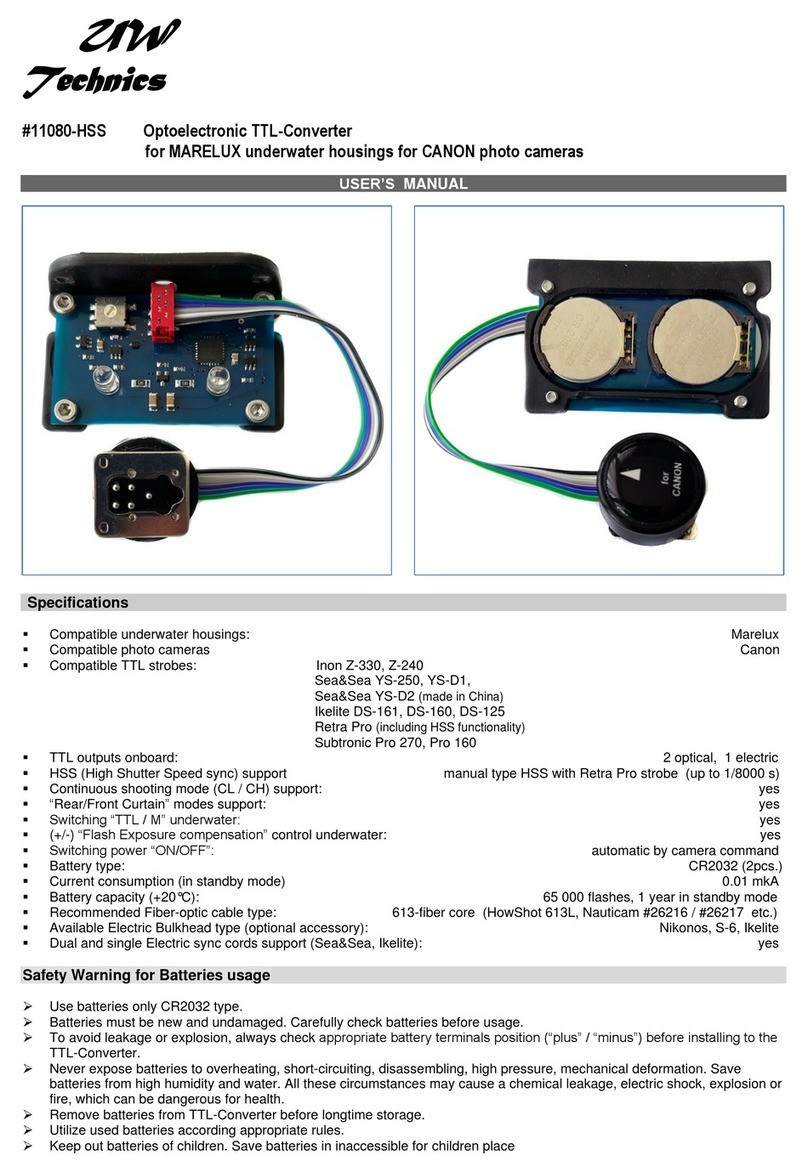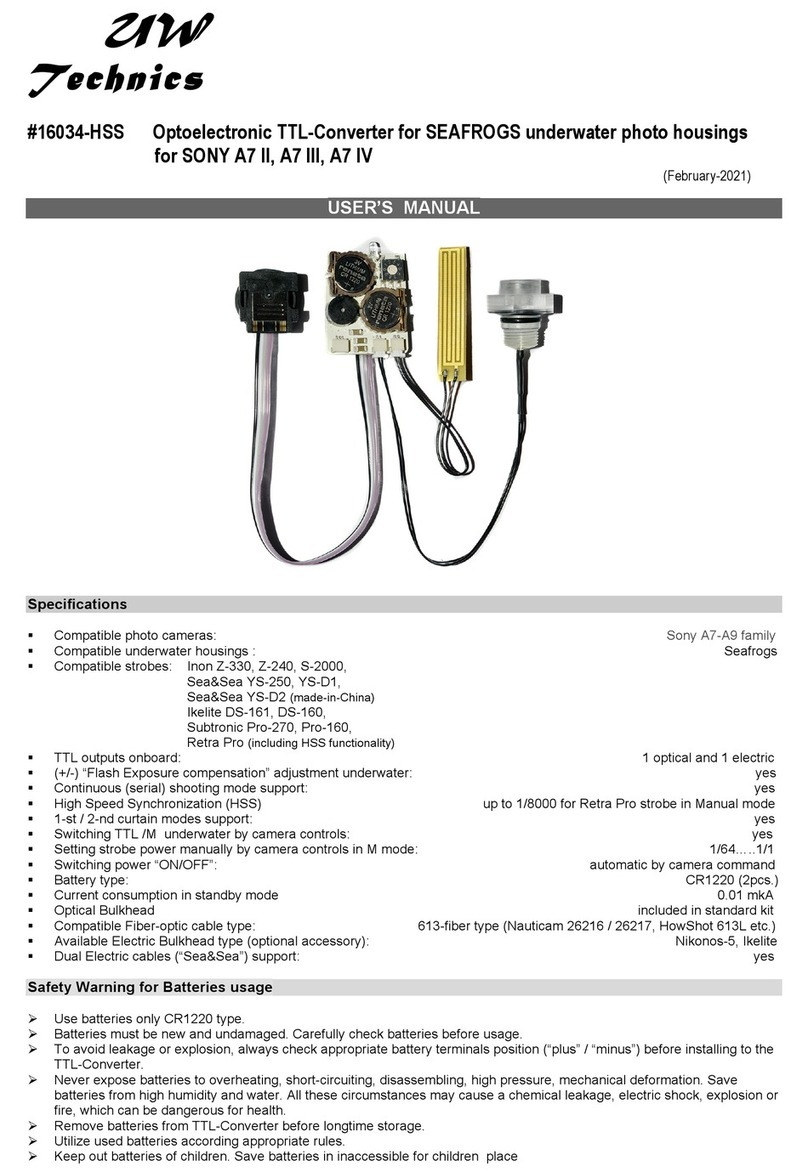oUnderwater Strobe Manual Mode (set by underwater strobe dial switch):
Set underwater strobe dial switch to M mode without pre-flashes. Adjust strobe light intensity by the dial
switch on the strobe body.
Shooting in this mode, it is strongly recommended to set TTL-Converter also to M mode (by camera menu “WL”
command), to exclude Pre-flashes in system (for energy saving).
oTTL-Converter Hardwire Manual Mode (set by onboard switch to “0” position):
Set TTL-Converter onboard rotary switch to “0” position.
Set underwater strobe to M mode without pre-flashes by dial switch on the strobe body. Adjust strobe light
intensity by the dial switch on the strobe body.
Setting TTL-Converter rotary switch to “0” position can be done only before closing the case, while the housing is open.
This is a hardwired Manual mode. In this mode the camera does not recognize any device on it’s HotShoe socket, TTL
protocol in system is totally disabled.
In this mode TTL-Converter emits single pulse of fixed (maximum) duration, without Pre-flashes.
This mode is recommended for any creative shooting, for example using long length fiber optical cables (up to 40m
length is supported), or for usage with TTL incompatible underwater strobes, or for any other difficult situations.
High Speed Synchronization (HSS) with Retra Pro strobe
▪New generation Retra Pro strobe supports High Speed Synchronization (HSS).
▪HSS shutter speeds are available for underwater flash usage in range 1/320 ….1/8000 for Sony A7-A9 cameras.
▪Pay attention, that Retra HSS is a Manual type HSS, but not TTL. In HSS strobe mode Retra flash intensity can be
adjusted by the strobe knob, only manually.
▪For shooting with Retra HSS, use the following settings:
➢Only once: Assign “HSS” function to U1 or U2 switch position on the strobe body, using “Retra-UWT” application via
I-Phone or I-Pad bluetooth connection.
➢Set Retra Pro strobe switch to U1 or U2 position (according the assigned position for HSS mode)
➢Set Manual flash mode for the system by camera menu (using “WL” command).
➢Use camera at any shutter high speeds (1/320 …1/8000). Test shooting with HSS flash. Adjust necessary flash
intensity by the strobe knob.
Shutter High Speeds availability for shooting with ambient light
▪Classic underwater strobes produce a mono-flash, they cannot work in HSS range speeds (excluding Retra Pro), camera
automatically limits sync speed 1/250 for them, usually until HotShoe plug is connected. But new TTL-Converter firmware
allows shutter high speeds usage for shooting underwater with ambient sunlight (without flash) even if HotShoe plug is
connected. User does not need to reopen the housing to disconnect the HotShoe plug.
▪Shutter high speeds for shooting are available in Manual mode of the system (use “WL” command) in range 1/320
….1/8000 (and faster, dependently of camera model). All models uw strobes (excluding Retra Pro) in this case don’t
produce a flash, automatically via TTL-converter control.
Continuous (Serial) Shooting using underwater strobes
▪TTL-Converter supports Continuous shooting in all modes, including TTL and M modes. But the main role in this case plays
underwater strobes specific (read below).
▪Compact size underwater strobes like Z240, Z330, S2000, YS-D1, YS-D2 etc. have rather weak charger inside, which can
not charge the strobe quick enough between series of TTL doubled flashes (pre-flash + main flash). Each next shot the
energy is not enough to keep accurate pre-flash duration. That is why, compact size underwater strobes are not
recommended for Continuous (Serial) Shooting in TTL mode. The 1st shot will have normal lighting, next shots will have
different lighting or none at all. The effect depends on specific strobe’s capabilities.
▪Large size underwater strobes, like YS-250, DS-161, DS-160 etc. have more powerful charger inside and large main
capacitor. Those strobes work some better in Continuous (Serial) Shooting TTL mode. The user can make more shots with
acceptable lighting. However the best lighting accuracy will be on only the first 1-3 shots in series, the others may have
different lighting. The effect depends on specific strobe’s capabilities.
▪For Continuous (Serial) Shooting with underwater strobes, it is strongly recommended to use Manual mode and set small
flash intensities manually.This way it is possible to get serial shots with acceptable lighting accuracy due to reduced
recycle times.
Battery energy saving
▪Set acceptable “Power Save Start Time” in camera menu, this is important for TTL-Converter battery saving. Strongly
recommended value –10 seconds.

























